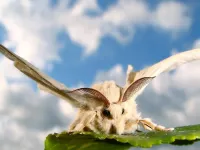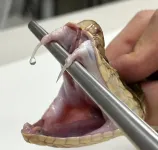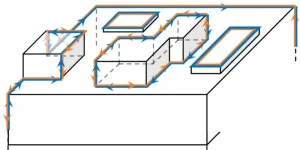(Press-News.org) The world smells different for female silkmoths than for males
In humans, the sense of smell is similarly developed in men and women, although women have slightly more olfactory neurons and therefore a slightly more sensitive nose. On the whole, however, they perceive the same odors. Male moths, on the other hand, live in a completely different olfactory world to their female counterparts. For example, the antennae of male silkmoths - their "nose" - are highly specialized to detect female sex pheromones, while females cannot even smell their own pheromones. There are thousands of sensilla on the antennae, hair-like structures, which can be divided into morphologically and functionally distinct groups. The most common sensilla in males are long and contain two sensory neurons. One is specialized to detect bombykol, the sex pheromone of females, while the other responds to bombykal, a component of the pheromone of other moth species. While bombykol is highly attractive to male silkmoths, bombykal is a deterrent.
"Because female silkmoths cannot smell their own pheromone, it was long thought that their long sensilla also have a very specific function that is only found in females. After mating, the female's only task is to find a suitable plant on which to lay her eggs. It has therefore been suggested that the long sensilla of females are specialized to detect the attractive odor of mulberry trees. We wanted to test this assumption", says Sonja Bisch-Knaden, who leads a project group in the Department of Evolutionary Neuroethology at the Max Planck Institute for Chemical Ecology.
Long sensilla of female silkmoths recognize silkworm feces
Electrophysiological methods, such as measuring the activity of individual sensilla (single-sensillum recording), were crucial for the study’s results. The scientists not only tested many different individual odors, but also natural odor mixtures, such as those found in the leaves of the mulberry tree, caterpillar droppings, the body odor of moths or the meconium, a liquid that moths secrete when they hatch. All these odors, which play an ecological role in the silkmoth's environment, had been collected. The research team was also able to match the expression of olfactory receptors to the corresponding sensillum type.
"We were surprised to find that neurons in the long sensilla of female silkmoths were not specialized to detect the odor of the host plant, as expected, but that one of the two neurons in the long sensilla is very sensitive to odors such as isovaleric acid and benzaldehyde. The detection of the odor of the mulberry leaf itself is carried out by neurons in medium-length sensilla", summarizes Sonja Bisch-Knaden.
Isovaleric acid and benzaldehyde are odor components of silkworm feces. Using a simple Y-maze test with an entrance arm that splits into two side arms through which either an odor or clean air (control) is introduced, the research team was able to elicit behavior in the otherwise immobile females that expressed attraction or aversion. Major differences became apparent when comparing virgin and mated females. The researchers showed that odors associated with caterpillar droppings did not trigger a specific reaction in virgin females, but had a deterrent effect on mated females. Presumably, the smell of feces helps females avoid mulberry trees, which are already full of silkworms when they lay their eggs.
In search of the male silkmoth pheromone
The pheromone of female silkmoths, bombykol, was chemically characterized as early as 1959 - the first insect pheromone ever. So far, scientists have not been able to identify a male counterpart. The current study provides clues, but no answers to the question of a male pheromone. "The second neuron in the females’ long sensilla is highly specific for (+)-linalool, an odor already identified as a component of the male pheromone in other butterfly species. However, no linalool could be found in the body odor of male silkmoths, and (+)-linalool alone had neither an attractive nor a repellent effect on female silkmoths in behavioral experiments", says Sonja Bisch-Knaden.
Special features of the odor perception of silkmoths
While investigating the molecular basis of odor detection in female silkmoths, the researchers noticed a peculiarity in the spatial organization of olfactory receptors. There are two families of olfactory receptors, the evolutionary older ionotropic receptors (IRs), which detect mainly acids, and the odorant receptors (ORs), which detect a wide range of chemically diverse compounds. Based on studies in the model fly Drosophila melanogaster, it was long thought that neurons expressing IRs or ORs usually occur in different types of sensilla, and that IRs never occur in long sensilla. In the silkmoth, however, an IR co-receptor for the detection of acids and the obligate OR co-receptor are both found in the same neurons located in long sensilla. This co-expression of IRs and ORs increases the chemical receptivity of the sensory neurons. Odors detected by both receptor types are processed and transmitted together, which could be advantageous for the unambiguous detection of ecologically important odor mixtures. "It is amazing that research on insect olfaction continues to produce surprising results. Our study shows that it is important to study more than just one model," says Bill Hansson, head of the Department of Evolutionary Neuroethology.
The researchers also found this co-expression of the two receptor types in the long sensilla of male silkmoths, which is why they assume that the detection of acids could also play an important ecological role in males. Further investigations will now clarify this.
END
Silkmoths: Different olfactory worlds of females and males
Female moths primarily use their sense of smell to find the best host plants on which to lay their eggs, with the deterrent effect of caterpillar feces playing an important role
2024-01-17
ELSE PRESS RELEASES FROM THIS DATE:
Wrongly-enforced rules over “digital surrogates” by museums censors research and creative use, study warns
2024-01-17
Cultural institutions are censoring research, learning and creativity because of the way they police the reuse of digital copies of out-of-copyright artworks and artefacts, a new study warns.
Cultural institutions have created a “mess” by claiming and enforcing new rights over the reproduction images of works in their collections.
This allows museums and other organisations to refuse requests for the use of the images in education or research or charge high fees. This impedes free and creative expression and amounts to censorship, according to Dr Andrea Wallace from the University of Exeter Law School.
Researchers, educators and others regularly ...
Space solar power project ends first in-space mission with successes and lessons
2024-01-17
One year ago, Caltech’s Space Solar Power Demonstrator (SSPD-1) launched into space to demonstrate and test three technological innovations that are among those necessary to make space solar power a reality.
The spaceborne testbed demonstrated the ability to beam power wirelessly in space; it measured the efficiency, durability, and function of a variety of different types of solar cells in space; and gave a real-world trial of the design of a lightweight deployable structure to deliver and hold the aforementioned solar cells and power transmitters.
Now, with ...
Pediatric Cancer Research Foundation launches 2024 call for entries for scholarships for pediatric cancer survivors
2024-01-17
The Pediatric Cancer Research Foundation today announced a call for entries for its 2024 Cancer Survivor Scholarships. The Foundation will award $100,000 to eligible students – including graduating high school seniors, college, vocational and graduate students – to support these students in realizing happy, productive futures. “Beating cancer medically is just one part of creating a healthy, happy life. Achieving our purpose of ensuring survivors can spread their wings and soar requires ...
Novel drug for fatal type of heart failure proves safe and effective in phase 3 trial
2024-01-17
Pumping over 100,000 times a day, the heart is a critical muscle needed to deliver oxygen and nutrients to our organs to sustain healthy bodily function. Unfortunately, heart failure affects an estimated 6.2 million people in the U.S. and a staggering 64 million worldwide.
Of older patients with heart failure and abnormally thickened hearts, as many as one in five have an underdiagnosed, highly progressive and fatal condition called transthyretin amyloid cardiomyopathy, or ATTR-CM. The disease, which can be hereditary or develop spontaneously, is defined by an accumulation of misfolded transthyretin ...
Study reveals a reaction at the heart of many renewable energy technologies
2024-01-16
CAMBRIDGE, MA — A key chemical reaction — in which the movement of protons between the surface of an electrode and an electrolyte drives an electric current — is a critical step in many energy technologies, including fuel cells and the electrolyzers used to produce hydrogen gas.
For the first time, MIT chemists have mapped out in detail how these proton-coupled electron transfers happen at an electrode surface. Their results could help researchers design more efficient fuel cells, batteries, or other energy technologies.
“Our advance in this paper was studying and understanding the nature of how these electrons and protons couple ...
Water as a nonlinear medium for ultrabroadband white laser
2024-01-16
Scientists are making significant strides in the development of ultrabroadband white laser sources, covering a wide spectrum from ultraviolet to far infrared. These lasers find applications in diverse fields such as large-scale imaging, femto-chemistry, telecommunications, laser spectroscopy, sensing, and ultrafast sciences.
However, the pursuit faces challenges, particularly in the selection of appropriate nonlinear mediums. Traditional solid materials, while efficient, are prone to optical damage under high peak power conditions. Gas mediums, though ...
Ultrafast laser pulses could lessen data storage energy needs
2024-01-16
A discovery from an experiment with magnets and lasers could be a boon to energy-efficient data storage.
“We wanted to study the physics of light-magnet interaction,” said Rahul Jangid, who led the data analysis for the project while earning his Ph.D. in materials science and engineering at UC Davis under associate professor Roopali Kukreja. “What happens when you hit a magnetic domain with very short pulses of laser light?”
Domains are areas within a magnet that flip from north to south poles. This property is used for ...
Tests can reveal whether an antibody can turn into a killer
2024-01-16
What makes a soldier switch sides? That is a really good question. Especially when the soldier is an antibody that is supposed to defend the body against one of the world's most dangerous snake venoms but instead ends up helping the venom kill the body.
The question has become topical after a group of DTU researchers slightly changed how they tested an antibody that had previously proven promising as an antidote to snake venom. In the first experiment on mice, the damaging effect on muscle tissue from the venom of Bothrops Asper, ...
The surface knows what lies beneath: physicists show how to detect higher-order topological insulators
2024-01-16
Just like a book can’t be judged by its cover, a material can’t always be judged by its surface. But, for an elusive conjectured class of materials, physicists have now shown that the surface previously thought to be “featureless” holds an unmistakable signature that could lead to the first definitive observation.
Higher-order topological insulators, or HOTIs, have attracted attention for their ability to conduct electricity along one-dimensional lines on their surfaces, but this property is quite difficult to experimentally distinguish from other ...
Dr. Marcus D. Goncalves inducted into the American Society for Clinical Investigation
2024-01-16
Dr. Marcus D. Goncalves Inducted into the American Society for Clinical Investigation
Dr. Marcus D. Goncalves, the Ralph L. Nachman, M.D. Research Scholar and an assistant professor of medicine in the Division of Endocrinology, Diabetes and Metabolism at Weill Cornell Medicine, has been elected as a member of the American Society for Clinical Investigation (ASCI) for 2024.
The ASCI is one of the nation’s oldest nonprofit medical honor societies and focuses on the unique role of physician-scientists in research, clinical care and medical education. It is comprised of more than 3,000 physician-scientists representing ...
LAST 30 PRESS RELEASES:
Numbers in our sights affect how we perceive space
SIMJ announces global collaborative book project in commemoration of its 75th anniversary
Air pollution exposure and birth weight
Obstructive sleep apnea risk and mental health conditions among older adults
How talking slows eye movements behind the wheel
The Ceramic Society of Japan’s Oxoate Ceramics Research Association launches new international book project
Heart-brain connection: international study reveals the role of the vagus nerve in keeping the heart young
Researchers identify Rb1 as a predictive biomarker for a new therapeutic strategy in some breast cancers
Survey reveals ethical gaps slowing AI adoption in pediatric surgery
Stimulant ADHD medications work differently than thought
AI overestimates how smart people are, according to HSE economists
HSE researchers create genome-wide map of quadruplexes
Scientists boost cell "powerhouses" to burn more calories
Automatic label checking: The missing step in making reliable medical AI
Low daily alcohol intake linked to 50% heightened mouth cancer risk in India
American Meteorological Society announces Rick Spinrad as 2026 President-Elect
Biomass-based carbon capture spotlighted in newly released global climate webinar recording
Illuminating invisible nano pollutants: advanced bioimaging tracks the full journey of emerging nanoscale contaminants in living systems
How does age affect recovery from spinal cord injury?
Novel AI tool offers prognosis for patients with head and neck cancer
Fathers’ microplastic exposure tied to their children’s metabolic problems
Research validates laboratory model for studying high-grade serous ovarian cancer
SIR 2026 delivers transformative breakthroughs in minimally invasive medicine to improve patient care
Stem Cell Reports most downloaded papers of 2025 highlight the breadth and impact of stem cell research
Oxford-led study estimates NHS spends around 3% of its primary and secondary care budget on the health impacts of heat and cold in England
A researcher’s long quest leads to a smart composite breakthrough
Urban wild bees act as “microbial sensors” of city health.
New study finds where you live affects recovery after a hip fracture
Forecasting the impact of fully automated vehicle adoption on US road traffic injuries
Alcohol-related hospitalizations from 2016 to 2022
[Press-News.org] Silkmoths: Different olfactory worlds of females and malesFemale moths primarily use their sense of smell to find the best host plants on which to lay their eggs, with the deterrent effect of caterpillar feces playing an important role








